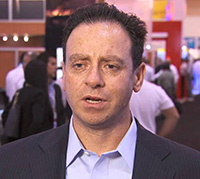 Iyad Tarazi, CEO
Iyad Tarazi, CEO The increasing traffic of wireless data has substantially raised the demand for ‘spectrum’—a highly valued resource in the wireless communications. A wave of shared spectrum innovation technology has ushered in to the wireless infrastructure landscape enabling multiple users to access the same spectrum resource simultaneously. However, the current system of spectrum allocation has laid down arms against the increasing wireless traffic. Coming to light is Federated Wireless that has designed solutions to cost effectively extract benefits of shared spectrum. “Federated Wireless’ Shared Spectrum technology leverages a dedicated network of sensors, manages interference, optimizes usage of spectrum resources, and provides an essential level of security for incumbent users of spectrum,” elucidates Iyad Tarazi, CEO, Federated Wireless.
To boost the performance of wireless broadband networks while optimizing capacity through higher utilization of spectrum, Federated Wireless has designed a three-tiered Spectrum Access System (SAS). The system enables efficient and secure allocation, sharing, and management of spectrum resources in real time. SAS offers access to spectrum across three levels of users including consumers, carriers, and incumbents. Federal systems can ensure non-interference from secondary wireless systems by using SAS, making it easier to bring more spectrum for commercial services in various locations. SAS protects federal system from revealing sensitive information by leveraging cognitive radio techniques, real time spectrum data, and advanced modeling tools. Further, users can get wireless access inside exclusion zones through SAS with minimum interference and maximum spectrum efficiency.
Additionally, the company’s CINQ XP provides shared spectrum access to service providers along with tools to plan and utilize the spectrum resources. Users can plan and configure networks on the shared spectrum using Federated Wireless’ CINQ XP with real time coverage and capacity. The tools offered help carriers to make informed decisions by determining the value of spectrum.
Also, it helps them with reporting and auditing capabilities integrating industry data on FCC approved database for spectrum allocation.

Federated Wireless’s Shared Spectrum technology leverages a dedicated network of sensors providing an essential level of security for incumbent users of spectrum
It enables service providers to scale their network on demand through its cloud based EPC network and services. “We believe that our Spectrum Access System and broad-based CINQ platform architecture will enable carriers and enterprises to extend wireless networks seamlessly and cost effectively,” asserts Tarazi.
Federated Wireless is currently conducting a 3.5 GHz band pilot program along with The National Advanced Spectrum and Communications Test Network (NASCTN) to validate Environmental Sensor Capability (ESC) for its SAS. The pilot test will accelerate the certification of SAS with Federal Communications Commission. “We are pleased that Federated Wireless is the first to pilot test with NASCTN. We look forward to our collaboration with NASCTN as we shape the future of the wireless industry,” ascertains Tarazi.
The company has carved a niche by incorporating a central network of radio sensors for interference free access to low cost licensed spectrum. Federated Wireless has set itself apart from the rest by removing the barriers of exclusive spectrum by bringing cost effective approaches to spectrum.
Forging ahead, the company aims to revamp the wireless landscape by moving bandwidth from a limited to abundant resource. Federated Wireless plans to enable enterprises to seamlessly use wireless networks both indoors as well as outdoors. The roadmap that Federated Wireless conceives is that of paving way for a connected world and propagating Internet of Everything (IoE). “We are committed to continuing our leadership in the development of Shared Spectrum technology,” concludes Tarazi.
 Iyad Tarazi, CEO
Iyad Tarazi, CEO